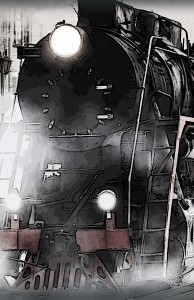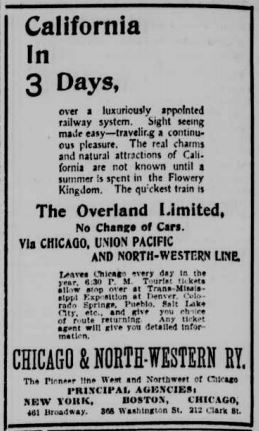 Welcome to another installment of “Where my research takes me,” an impromptu series of posts inspired by all the little odds and ends of Victoriana I collect in my book researches.
Welcome to another installment of “Where my research takes me,” an impromptu series of posts inspired by all the little odds and ends of Victoriana I collect in my book researches.
My new release, Unseemly Haste (book 4 of the Concordia Wells Mysteries), provided a treasure trove of research opportunity. The story is set in the summer of 1898, as my characters make their way from New York to San Francisco aboard a Pullman sleeper car train.
Want to see some of the cool things I ran across?
I’m so glad you said yes. *wink*
Planning the journey: the route from New York to San Francisco

Railway mergers, shared use agreements, and the standardization of track gauge, platform configurations, etc, made cross-country travel by rail easier than ever by the 1890s. The three-day trip covered 3,270 miles. For the route my characters took, four different railways were involved: the Pennsylvania RR, the Pittsburgh, Fort Wayne, and Chicago RR, the Central Pacific RR, and the Union Pacific RR. According to Appletons’ General Guide to the United States and Canada: Western and Southern states (D. Appleton and Company, 1889), the cost of the Chicago Limited Express (sleeper compartment included in the price) from New York to Chicago was $28, then from Chicago to San Francisco, aboard the Overland Limited, $72.50.
read more at Misterio Press (including the details of my new book, Unseemly Haste!)



Well next time I need to travel that route, I’m taking the train.
Thanks for sharing the fun stuff once again.
Patricia Rickrode
w/a Jansen Schmidt
Post pics of your adventure, Patricia! We’d love to see it. Thanks so much for dropping by and commenting! 🙂
You’ve touched on a subject dear to my heart. Thank you.
I’f I may add a correction to the route: West of Chicago, they would have traveled the Chicago & Northwestern to Omaha, then be handed over to the Union Pacific to Ogden, then the Central Pacific (by then taken over by the Southern Pacific) to San Francisco. This is essentially the same route I took in 1970 (a year before the creation of Amtrak) while traveling military standby ( thanks to the U.S. Coast Guard). By then the Pennsylvania had long since operated all the way to Chicago (the Broadway Limited). No through sleeper, though. At Chicago, one boarded the successor to the Overland Limited, the City of San Francisco. In the early 1950s, the Chicago-Omaha segment switched from the C & NW over to the Milwaukee Road.
I ask your forbearance. I realize this information may be tedious to anyone but a railroad enthusiast and a historian (I consider myself both). Will check out your book!
Paul, I really appreciate your input. I hope you and any other train enthusiasts who may check out my book will be forbearing with errors on my part. I consulted many original travel guides and timetables, cobbling together the route as best as I could. Experts who could answer my very specific questions were difficult to find at the time. Thanks!
In my historical novel, Beyond The Divide, that takes place in the 1890s, the protagonist rides the Southern Pacific from Portland, OR, down to southern California. I had him routed down through Klamath Falls–the current route of Amtrak’s Coast Starlight. Also the route followed when I rode Southern Pacific’s Cascade Limited in 1970.
To my chagrin, I since learned that that route didn’t open until the 1920s. The mainline before that followed the even more tortuous Siskiyou line, through Roseburg, Grant’s Pass and Medford.. I shall modify that part of my book accordingly.
A problem with historical writing is that even reputable sources are often inaccurate. And often contradict each other. In such cases, I suppose we are forced to chose what best suits the story. Thank you for your reply.
You are quite right! Your work sounds really interesting – I’ll definitely be looking that up.
I’ve totally thought of taking a train vacay with the family, straight up the West Coast to Oregon or Washington. I think my kid would love it. But I was shocked at how expensive it is when I looked. It’s very similar to flying, only you get a bed into the “bargain.” 🙂
You’re right, Jenny, it is expensive! And with the lower cost and shorter travel time of airplanes, long-distance train travel is kind of dying out. It’s still convenient for short trips, though, when you factor in how far in advance you have to get to the airport these days to clear security.